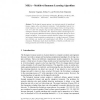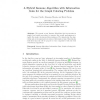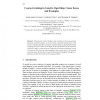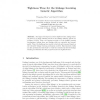GECCO
2003
Springer
14 years 4 months ago
2003
Springer
The biological immune system is an intricate network of specialized tissues, organs, cells, and chemical molecules. T-cell-dependent humoral immune response is one of the complex i...
GECCO
2003
Springer
14 years 4 months ago
2003
Springer
Abstract. This paper provides an empirical test of a hypothesis, which describes the effects of structural mechanisms in genetic programming. In doing so, the paper offers a test p...
GECCO
2003
Springer
14 years 4 months ago
2003
Springer
This paper presents methods to visualize the structure of trees that occur in genetic programming. These methods allow for the inspection of structure of entire trees of arbitrary ...
GECCO
2003
Springer
14 years 4 months ago
2003
Springer
This paper presents a hypothesis about an undiscovered class of mechanisms that exist in standard GP. Rather than being intentionally designed, these mechanisms would be an uninten...
GECCO
2003
Springer
14 years 4 months ago
2003
Springer
We present a new Immune Algorithm that incorporates a simple local search procedure to improve the overall performances to tackle the graph coloring problem instances. We character...
GECCO
2003
Springer
14 years 4 months ago
2003
Springer
Following the work of Stephens and coworkers on the coarse-grained dynamics of genetic systems, we work towards a possible generalisation in the context of genetic algorithms, givi...
GECCO
2003
Springer
14 years 4 months ago
2003
Springer
This paper investigates whether optimisation techniques can be used to evolve artifacts of cryptographic significance which are apparently secure, but which have hidden properties...
GECCO
2003
Springer
14 years 4 months ago
2003
Springer
A network with restoration capability requires spare capacity to be used in the case of failure. Optimization of spare capacity is to find the minimum amount of spare capacity for ...
GECCO
2003
Springer
14 years 4 months ago
2003
Springer
The emergence of multimedia data in databases requires adequate methods for information retrieval. In a music data retrieval system by humming, the first stage is to extract exact...
GECCO
2003
Springer
14 years 4 months ago
2003
Springer
Abstract. This paper develops a model for tightness time, linkage learning time for a single building block, in the linkage learning genetic algorithm (LLGA). First, the existing m...




